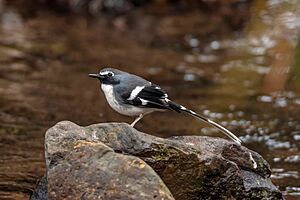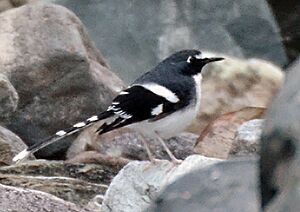Slaty-backed forktail facts for kids
Quick facts for kids Slaty-backed forktail |
|
|---|---|
 |
|
| in Godawari, Nepal. | |
| Conservation status | |
| Scientific classification | |
| Genus: |
Enicurus
|
| Species: |
schistaceus
|
The slaty-backed forktail (Enicurus schistaceus) is a cool bird that lives near streams and rivers. It's part of the Muscicapidae family, which includes Old World flycatchers. This bird is medium-sized and slim. You can tell it apart by its grey head and back.
It has a long tail that looks like a fork, with black and white stripes. Its bottom (rump) is white, and it has a white stripe on its wings. Most of its body is white. Male and female slaty-backed forktails look the same. These birds like to hop on rocks near fast-flowing water. They hunt small bugs there or fly over the water to catch them. They lay 3–4 eggs between February and July. Both parents help keep the eggs warm.
You can find the slaty-backed forktail in warm and mild areas near streams and rivers. Sometimes, they even go near roads or paths. They usually like to be alone. But sometimes, you might see them in pairs. During the time they have babies, you might see them in family groups. One of their calls sounds like a small kingfisher. People have even mixed them up with the Blyth's kingfisher! These birds live in the Himalayas, Indian Sub-continent, southern China, and Southeast Asia. There are many of them, and their numbers seem steady. So, experts say they are not in danger.
Contents
About the Slaty-backed Forktail's Name
The slaty-backed forktail got its scientific name in 1836. A British scientist named Brian Houghton Hodgson described it. He first put it in a group with birds called wagtails. The bird's name, schistaceus, is a Latin word. It means "slaty-grey," which describes its color. Today, this bird is in the Muscicapidae family. This family includes birds like Old World flycatchers and chats.
What the Slaty-backed Forktail Looks Like

The slaty-backed forktail is a slim, medium-sized bird. It is about 22 to 25 centimeters (9 to 10 inches) long. It weighs about 26 to 38 grams (0.9 to 1.3 ounces). Its colors are slate-grey, black, and white. Its beak is black, and its feet are a light pink or grey. Its eyes are usually dark brown, but sometimes they look black.
It has a black throat and a thin white stripe on its face. This stripe goes back behind its eyes. Sometimes, it looks like a white mask. Its cheeks, chin, and face are also black. The top of its head, neck, and shoulders are slate grey. Its wing feathers are black with a white patch at the bottom. It also has wide white stripes on its wings. There is a big white patch on its lower back.
The bird's tail is long and has a deep fork shape. The tail is mostly black with a white tip. It also has three white stripes along its tail. These stripes are made by the white tips of shorter tail feathers.
Young Birds and Differences
Young slaty-backed forktails look a bit different. They don't have a white forehead. Their upper body is brown, and their chest has dark scales. Their tail is shorter than adult birds. Young birds also have grey or yellowish areas near their eyes. Their chin and throat can be grey or white. Their sides are a dull grey-brown.
Male and female slaty-backed forktails look the same. This means they are not sexually dimorphic. The slaty-backed forktail looks a lot like the black-backed forktail. But you can tell them apart by the slate-grey color on its head and back. That's how it got its name! It also has a slightly bigger beak and a little less white on its forehead.
Bird Calls
One call of the slaty-backed forktail sounds like a "high, thin, sharp, metallic screech." It's like a small kingfisher's call. People have even confused it with the Blyth's kingfisher. Another call is a soft "cheet." When the bird is worried, it makes a harsh, repeated screeching sound.
Where the Slaty-backed Forktail Lives
The slaty-backed forktail lives near fast-flowing water. It prefers tropical and subtropical mountain forests. You can also find it near farms. It likes rocky streams and rivers, even wide ones in flat areas. One study found that these birds like streams with lots of plants. They also prefer streams with firm banks and fine sand at the bottom. Sometimes, you might see them in quiet forest areas. They can also be found on the sides of roads near water. In winter, they might move from mountains to lower hills and plains.
You can find this bird in the central and eastern Himalayas. This includes Uttarakhand in India, Nepal, and Bhutan. It also lives in Myanmar. Sometimes, it visits Bangladesh. It is found in southern China, including Tibet and other provinces. Its range in Southeast Asia includes Thailand, Vietnam, Laos, Cambodia, Malaysia, and Hong Kong. In Hong Kong, it's rare to see them.
The height where they live changes by location. In northern India, they live from 300 to 1600 meters (about 1,000 to 5,200 feet) above sea level. In Nepal, it's 900–1675 meters (about 3,000 to 5,500 feet). In Bhutan, it's 800–2200 meters (about 2,600 to 7,200 feet). In winter, they can be seen as low as 200 meters (about 650 feet).
The area where this bird lives is very large. There are many of these birds, probably more than 10,000. Their numbers seem stable. Because of this, experts say they are a species of "least concern." This means they are not currently in danger.
Life Cycle and Behavior
The slaty-backed forktail has its babies between February and July. This time frame doesn't change much across different places. They build their nests using things like moss, leaves, and grass. The nest can be shaped like a cup or part of a dome. It depends on where they build it. Often, the outside of the nest is covered in mud.
They build nests in holes in the ground or tree trunks. They also build them between tree roots or in hollow dead trees. Sometimes, they use cracks in rocks. The female bird lays three to four eggs. The eggs can be white, pinkish-white, or bluish-white. They have lavender or reddish-brown spots. The spots are usually more common on the wider end of the egg. Both the male and female birds take turns sitting on the eggs to keep them warm. These birds might have two or three groups of babies in one year.
What They Eat and How They Hunt
Slaty-backed forktails eat small bugs that live in or near the water. This includes insect larvae and tiny crabs. They look for food at the edge of the water. They are always moving around. They hop on and among rocks near the water and even in the middle of the stream. Sometimes, they go into the water too. They are very good at hopping on rocks. They also fly quickly over the water to grab food from the surface.
Their flight is fast and straight, a bit like a large wagtail. You mostly see them near water. They are usually alone, but sometimes you see them in pairs. They are described as shy birds. They constantly bob their tails up and down. If something scares them, they might quickly raise and open their tail like scissors. During the breeding season, you might see them in small family groups. In winter, they are usually alone. However, many birds might gather to find food in a good part of a stream. For example, 15 birds were once seen along one part of a river in Bhutan.
In Southeast Asia, these birds usually stay in the same area. But in the Himalayas, they move to different heights depending on the season. One study found that they moved locally when water levels rose during the monsoon season.



